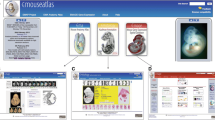Abstract
The Edinburgh Mouse Atlas Project (EMAP) is a time-series of mouse-embryo volumetric models. The models provide a context-free spatial framework onto which structural interpretations and experimental data can be mapped. This enables collation, comparison, and query of complex spatial patterns with respect to each other and with respect to known or hypothesized structure. The atlas also includes a time-dependent anatomical ontology and mapping between the ontology and the spatial models in the form of delineated anatomical regions or tissues. The models provide a natural, graphical context for browsing and visualizing complex data.
The Edinburgh Mouse Atlas Gene-Expression Database (EMAGE) is one of the first applications of the EMAP framework and provides a spatially mapped gene-expression database with associated tools for data mapping, submission, and query. In this article, we describe the underlying principles of the Atlas and the gene-expression database, and provide a practical introduction to the use of the EMAP and EMAGE tools, including use of new techniques for whole body gene-expression data capture and mapping.
Similar content being viewed by others
References
Baldock, R. A., Bard, J., Kaufman, M. H., and Davidson D. (1992) A real mouse for your computer. BioEssays 14, 501–502.
Baldock, R. A. and Hill, W. (1999) Image Warping and Spatial Data Mapping, Image Processing and Analysis: A Practical Approach. (Baldock, R. A. and Graham, J., eds.) Oxford University Press, Oxford, UK, pp. 261–288
Bard, B. L. B., Kaufman, M., Dubreuil, C., et al. (1998) An internet-accessible database of mouse developmental anatomy based on a systematic nomenclature. Mechanisms Dev. 74, 111–120.
Brune, R., Bard, J. B. L., Dubreuil, C., et al. (1999) A three-dimensional model of the mouse at embryonic day 9. Dev. Biol. 216, 457–468.
Davidson, D., Bard, J., Brune, R., et al. (1997) The mouse atlas and graphical gene-expression database. Seminars Cell Dev. Biol. 8, 509–517.
Downes, K. M. and Davies, T. (1993) Staging of gastrulating mouse embryos by morphological landmarks in the dissecting microscope. Development 118, 1255–1266.
Kaufman, M. H. (1992) The Atlas of Mouse Development, Academic Press, London, UK.
MacKenzie-Graham, A., Jones, E. S., Shattuck, D. W., Dinov, I., Bota, M., and Toga, A. W. (2003) The informatics of a C57BL/6 mouse brain atlas. Neuroinformatics 1, 397–410.
Martone, M. E., Zhang, S., Gupta, A., et al. (2003) The cell-centered database: a database for multiscale structural and protein localization data from light and electron microscopy. Neuroinformatics 1, 379–396.
Rosen, G. D., La Porte, N. T., Diechtiareff, B., et al. (2003) Informatics center for mouse genomics: the dissection of complex traits of the nervous system. Neuroinformatics 1, 327–342.
Sharpe, J., Ahlgren, U., Perry, P., et al. (2002) Optical projection tomography as a tool for 3D microscopy and gene expression studies. Science 296, 541–545.
Theiler, K. (1989) The house mouse: Atlas of embryonic development. Springer Verlag, New York.
Author information
Authors and Affiliations
Corresponding author
Rights and permissions
About this article
Cite this article
Baldock, R.A., Bard, J.B.L., Burger, A. et al. EMAP and EMAGE. Neuroinform 1, 309–325 (2003). https://doi.org/10.1385/NI:1:4:309
Issue Date:
DOI: https://doi.org/10.1385/NI:1:4:309




